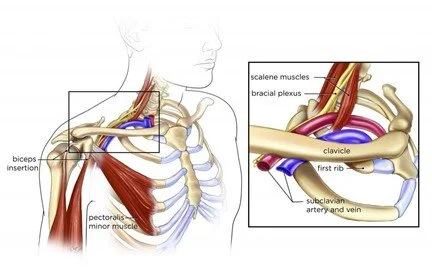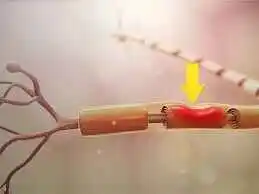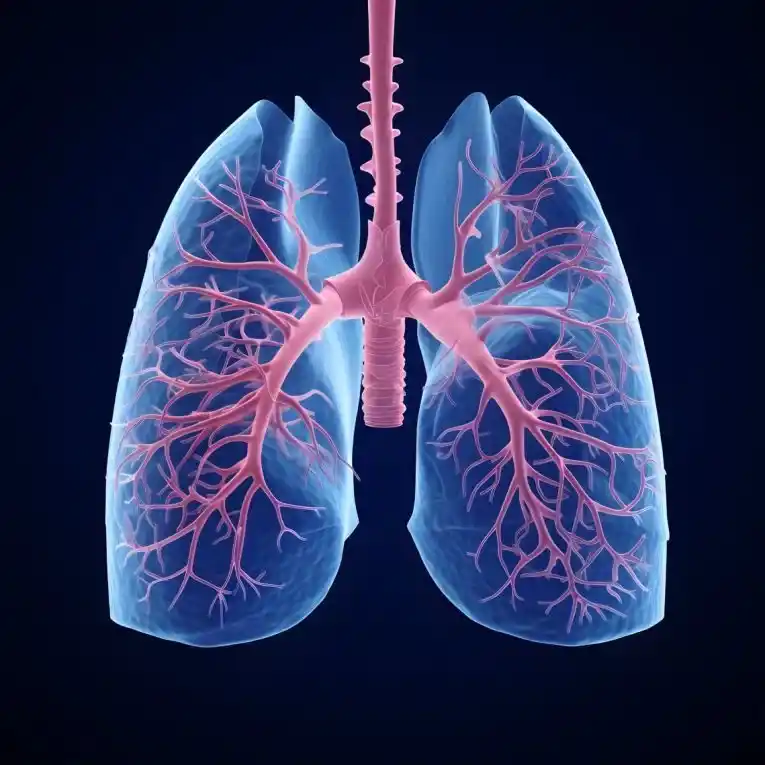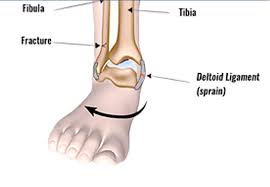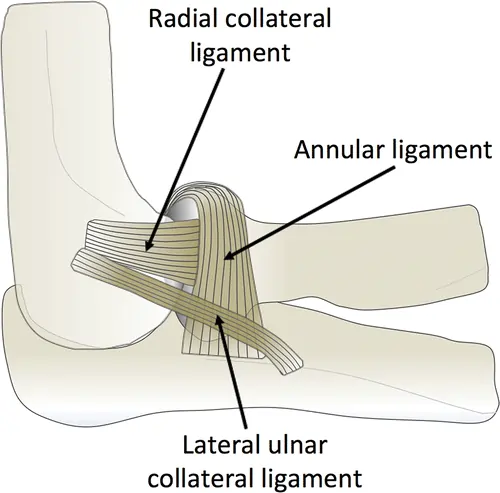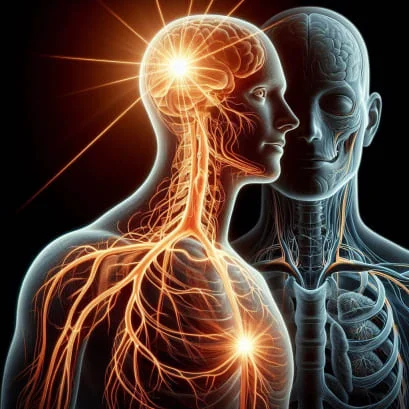Costoclavicular syndrome
Introduction
Costoclavicular Syndrome, commonly known as Thoracic Outlet Syndrome (TOS), is a medical disorder characterized by nerve or blood vessel compression in the thoracic outlet. The thoracic outlet is the gap between the clavicle (collarbone) and the first rib, through which essential structures such as nerves and blood arteries go from the neck to the arms.
The superior thoracic outlet, costoscalene hiatus, and costoclavicular syndrome are the three exits that make up a costoclavicular syndrome. Differences in anatomy, such as having an additional or uneven rib, can potentially lead to costoclavicular syndrome. Sometimes the reason for the costoclavicular syndrome is unknown.
Physical therapy and pain reduction are frequently used as treatment options. Most people improve after receiving these therapies. For some, surgery may be necessary.
What is Costoclavicular Syndrome?
Compression of nerves, blood vessels, or both in the thoracic outlet is a defining feature of the costoclavicular syndrome, sometimes referred to as Thoracic Outlet Syndrome (TOS). From the neck to the arm, vital structures such as blood vessels and nerves pass through the thoracic outlet, which is the gap between the first rib and the clavicle (collarbone).
A costoclavicular syndrome is comprised of three outlets: costoscalene hiatus, superior thoracic outlet, and costoclavicular syndrome. The scapula posterior side, the first rib medial side, and the clavicle anterolaterally form the costoclavicular canal. The brachial plexus, subclavian artery, and subclavian vein all meet at the costoclavicular entry, which is found beneath the clavicle and the first rib. The neurovascular bundle is squeezed in this situation.
Mechanism of Costoclavicular Syndrome Mechanism
The initial reports of the costoclavicular syndrome were made by soldiers who were carrying heavy backpacks and experienced hand weariness, numbness, and pain when on alert (attention). The clavicle’s downward movement (activity) against the first rib was one of the compression mechanisms that led to the propensity to sever the neurovascular bundle.
Three things can happen this:
- The clavicle gets pushed beneath or under the first rib. Shoulders that are rounded and drooping are indicative of this general stance. The scapula is forced forward as a result of the costoclavicular passage narrowing.
- Another possible explanation is a tight subclavian. Usually, a similar mechanism is in play in middle-aged, older, or obese women. Tight, thin brassiere straps that give heavy breasts press down directly on the collarbone, typically where the middle and lateral thirds meet, and tear into the sensitive tissue around the shoulder muscles. The clavicle’s scissoring action along the first rib cuts the nerve group and shrinks the costoclavicular passage.
- The clavicle is sometimes contacted or repelled by the first rib. Clients who have respiratory issues frequently experience this. It could be due to tight subclavius and front and middle scales.
Cause of the Costoclavicular Syndrome
- Bad posture: The symptoms of the costoclavicular syndrome can be caused by slouching or keeping the head forward, which can compress the thoracic outlet’s blood vessels and nerves.
- Trauma: A prior injury, such as a whiplash injury, collarbone fracture, or shoulder dislocation, may result in structural alterations in the thoracic outlet region, which may compress or irritate blood vessels or nerves.
- Anatomical abnormalities: Certain people may be at risk for thoracic outlet compression due to naturally occurring anatomical differences. Examples of these anomalies include a small thoracic outlet, improper muscle growth, or cervical ribs—extra ribs close to the neck.
- Repetitive activities: Prolonged and repeated activities involving overhead arm movements, like baseball, swimming, or certain sports, or work-related duties like lifting heavy objects or using a computer repeatedly, can cause stress on the thoracic outlet’s structures, resulting in irritation or compression.
- Muscle problems: Imbalances in the muscles in the shoulder region and neck can alter the posture and integrity of the thoracic outlet structures, potentially resulting in nerve and blood vessel compression.
- Tumors or masses: Rarely, unusual growths or tumors in the thoracic outlet region, like an expanded blood artery or a cervical rib tumor, might compress the nerves or blood vessels and cause costoclavicular syndrome.
Symptoms of Costoclavicular Syndrome
- Pain in the arm, shoulder, and neck: This pain is usually characterized as a sharp, shooting pain that may radiate down the arm or as a dull ache. Certain postures or activities, including reaching upwards or moving heavy objects, may make the pain worse.
- Numbness or tingling: In the affected hand or arm, you could feel numb, tingly, or like you have pins and needles. This may affect the inside of the forearm, the finger rings and tiny fingers, or the entire hand.
- Weakness: It may be difficult to grasp things or carry out specific duties if there is weakness in the arm or hand.
- Swelling or discoloration: Sometimes, poor circulation can result in swelling or discoloration (bluish or purplish) of the afflicted hand or arm.
- Temperature sensitivity or coldness: The affected hand or arm may feel colder than the rest of the body or be more susceptible to temperature fluctuations.
- Muscle atrophy: The affected arm may have muscle atrophy or wasting as a result of long-term nerve compression in the thoracic outlet.
- Restricted range of motion: It could be difficult to carry out specific movements if you have a reduced range of motion in your arm, shoulder, or neck.
- It is crucial to remember that these symptoms might change based on the precise structures being crushed as well as the underlying cause. For a precise diagnosis and suitable therapy, it is advised that you speak with a healthcare provider if you think you might have costoclavicular syndrome.
Risk factors of the Costoclavicular Syndrome
- Participating in sports that require repetitive shoulder or arm movements may increase your risk of acquiring thoracic outlet syndrome. Baseball, swimming, golf, and volleyball are a few examples.
- Try lifting weights.
- Lift objects over your head or carry big shoulder weights regularly.
- Sustained a back or neck concussion injury.
- Possess huge lymph nodes or masses in your armpit or upper chest.
- Have bad posture.
Diagnosis of the Costoclavicular Syndrome
Medical history:
To begin, your doctor will question you about your symptoms, how long they have persisted, and what triggers or relieves them. Inquiries on your medical history, any injuries, and any occupations or activities that might be linked to the development of thoracic outlet syndrome will also be made.
Physical examination:
To evaluate your range of motion, muscle strength, and feeling in the region that is affected, a comprehensive physical examination is conducted. Your doctor will check your arm, shoulder, and neck for any indications of muscular atrophy, soreness, or edema. They might also assess how your ribs and collarbone move and arrange themselves.
Provocative tests:
Your doctor may use particular techniques to mimic or intensify your symptoms. To support the diagnosis, these tests are designed to squeeze the thoracic outlet’s blood vessels or nerves. Provocative tests consist of the costoclavicular maneuver, Wright test, Roos test, and Adson’s test.
Imaging studies:
Imaging tests may be prescribed to view the thoracic outlet’s anatomy and detect any anomalies or compression. These may consist of:
- X-rays: X-rays can be used to evaluate the position and alignment of the neck and shoulder bones as well as identify any anomalies, such as fractures or other skeletal abnormalities, that might be causing the compression.
- Magnetic Resonance Imaging (MRI): The soft tissues of the thoracic outlet, such as the muscles, blood vessels, and nerves, can be seen in great detail on magnetic resonance imaging (MRI) scans. This can assist in determining whether the compression is due to any structural anomalies, such as tumors or ruptured discs.
- Computed Tomography (CT) scan: CT scans can produce fine-grained cross-sectional pictures of the thoracic outlet’s structures, making skeletal anomalies like tumors or bone spurs easier to see.
- Electrical activity and conduction of the nerves in the afflicted area are assessed by nerve conduction studies (NCS) and electromyography (EMG) tests. They can assist in identifying whether nerve compression or injury is present and how severe it is.
Differential Diagnosis of Costoclavicular Syndrome
- Cervical radiculopathy: In this condition, a nerve root in the neck or cervical spine may become crushed or inflamed. It may lead to discomfort in the neck, shoulders, and arms in combination with numbness, tingling, and weakening. Though thoracic outlet syndrome may impact a wider distribution, the symptoms are usually restricted to a particular dermatome or patch of skin innervated by a particular nerve root.
- Brachial plexopathy: The brachial plexus, a group of nerves that emerge from the spinal cord in the neck and supply the hand, arm, and shoulder, is affected by brachial plexopathy. Similar symptoms of thoracic outlet syndrome, such as pain, numbness, tingling, and weakness in the afflicted arm, can be caused by injury or compression of the brachial plexus.
- Rotator cuff injury: Pain and reduced ability to move in the arm and shoulder may result from the destruction or infection of the muscles and tendons that sustain the shoulder joint. Like thoracic outlet syndrome, some movements or activities may make the symptoms worse.
- Peripheral neuropathy: Damage or malfunction of the peripheral nerves, usually in the limbs, is referred to as peripheral neuropathy. Signs which include discomfort, tingling, numbness, and weakness in the hands and arms could arise from it. Peripheral neuropathy is frequently caused by infections, diabetes, vitamin deficiencies, and some drugs.
- Frozen shoulder (also known as adhesive capsulitis): This ailment, which frequently occurs after an injury or extended immobility, is characterized by stiffness and pain in the shoulder joint. Although there may be a limited range of motion and pain that travels down the arm, the neck is usually not affected, and there are usually no neurological signs.
- Vascular disorders: Pain, swelling, discoloration, and temperature changes in the arms might be symptoms of conditions that impact the blood vessels, such as thrombosis or arterial or venous compression. To distinguish between these symptoms and thoracic outlet syndrome, a thorough evaluation is required.
Treatment of Costoclavicular Syndrome
The degree of symptoms and the underlying reason determine the course of treatment for the costoclavicular syndrome. The initial line of treatment is frequently conservative measures including physical therapy, posture correction, and activity moderation. Medical treatments such as prescription drugs, corticosteroid injections, or in certain situations, surgery, may be advised in more severe cases or when conservative measures are insufficient to relieve the condition.
To reduce symptoms and avoid potential problems related to Costoclavicular Syndrome, early detection and effective care are crucial. It’s critical to get medical help as soon as possible if you have ongoing hand, arm, or shoulder pain to have a precise diagnosis and a customized treatment strategy.
Medical treatment
- Pain management: Ibuprofen and naproxen are two examples of over-the-counter nonsteroidal anti-inflammatory medicines (NSAIDs) that can help relieve pain and lower inflammation. To treat extreme pain or muscle spasms, your doctor may occasionally recommend stronger painkillers or muscle relaxants.
- Injections: To temporarily alleviate extreme pain or inflammation, corticosteroid injections may be utilized. To lessen inflammation and alleviate symptoms, these injections are given straight into the problematic location.
- Blood clot-dissolving medication: Your doctor may inject thrombolytics (a blood clot-dissolving medication) into your veins or arteries if you have arterial or venous thoracic outlet syndrome with blood clots. Your doctor might suggest anticoagulants, which stop blood clots, once thrombolytics are administered.
- Those with venous or arterial Costoclavicular Syndrome benefit from thrombolytic therapy. Medication that breaks existing blood clots and prevents them from developing is administered via an IV line or catheter. Additionally, your doctor may suggest anticoagulant medications.
Physical therapy:
- The most popular first line of treatment for neurogenic Costoclavicular Syndrome is physical therapy. A physical therapist helps you increase your range of motion, or the extent to which you can move, in your shoulders and neck. Moreover, physical treatment improves your posture and strengthens your muscles. The majority of neurogenic Costoclavicular Syndrome patients have a reduction in symptoms.
Surgical Treatment:
- When conservative treatments for costoclavicular syndrome, like physical therapy and medication, have not been successful in reducing symptoms, surgery is usually considered. Depending on the exact origin and severity of the illness, there are some surgical procedures available. Here are a few instances:
- First Resection of the Ribs: A surgical treatment known as first rib resection may be undertaken if the first rib anomaly or malformation is the primary source of the compression. To release the pressure on the blood vessels and nerves, the surgeon removes all or part of the first rib during this procedure.
- Scalene Muscle Release: The neck’s scalene muscles may occasionally be a factor in the thoracic outlet’s compression. To relieve pressure on the nerves and blood vessels, the surgeon performs scalene muscle release surgery, which involves cutting and releasing the tight scalene muscles.
- Thoracic Outlet Decompression: In this more involved surgical procedure, the structures that are compressing the thoracic outlet’s blood vessels and nerves are released or removed. The initial rib may be removed, any fibrous bands may be divided, or any aberrant muscles or other structures that are causing compression may be excisional.
Physical therapy for the Costoclavicular Syndrome
- The benefit of physical therapy is necessary for the managing of the costoclavicular syndrome. Its main goals are to increase flexibility, strengthen the muscles surrounding the neck and shoulders, and improve posture.
- Stretching methods, manual therapy, and therapeutic exercises can all help reduce discomfort, increase range of motion, and address any muscular imbalances.
- Correcting one’s posture is crucial to lessening the strain on the thoracic outlet’s blood vessels and nerves.
- Ergonomic modifications, including rearranging your office or employing safe lifting methods, can help reduce discomfort and enhance posture.
Exercises for the Costoclavicular Syndrome
Scapular Retraction
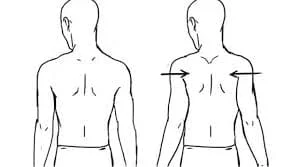
- Place your arms by your sides and either sit or stand up straight.
- Press your shoulder blades together slightly to drive them back and down.
- Release it after a few seconds to preserve the posture.
- Do this ten to fifteen times.
Shoulder rolls

- Maintain a straight posture while keeping your arms at your sides.
- Shape your shoulders into a circular motion and roll them forward.
- After ten to fifteen reps, switch directions and roll your shoulders back for ten to fifteen more repetitions.
Neck Stretching

- You can either sit or stand up straight with your shoulders relaxed.
- Angle your head to the right so that your right ear is closest to your right shoulder.
- After holding the muscle stretch for 15 to 30 seconds, go back to where you were before.
- On the left side, repeat.
- On either side, execute three to five repetitions.

Pectoral Stretch
- Set up your forearms on either side of the door frame while standing at an entrance.
- Put one foot forward to bring your body forward, then take a step ahead until your chest starts to extend.
- Sustaining the pectoral muscle stretch for 20 to 30 seconds is advisable.
- Do the stretch two or three times.
Thoracic-extension
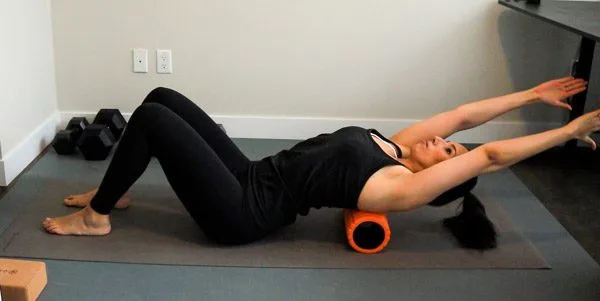
- Extend your upper back horizontally while seated on a towel that has been rolled up or a foam roller.
- You should support your head by tying your hands behind it.
- Allow the foam roller to support your upper back while you gently lean back over it.
- Return to the position of origin after maintaining it for 20 to 30 seconds.
- Do this two or three times.
Nerve Gliding Exercises:
- These exercises use particular motions to help the nerves travel freely and glide through the thoracic outlet. They ought to be carried out painlessly and gently. Since these exercises call for precise technique and coordination, a physical therapist can help you with them.
Prevention of Costoclavicular Syndrome
- The costoclavicular syndrome cannot always be avoided. You have no control over a lot of the circumstances. Nonetheless, you can reduce your risk by doing a few things things:
- If your sport requires you to make repetitive arm motions, discuss shoulder-strengthening exercises with your coach or trainer.
- Consult a healthcare professional about injury-prevention exercises if your employment involves heavy lifting or overhead arm movements.
Summary
Costoclavicular Syndrome may cause disruptions to your daily schedule. Slowing down at work or taking a break from your sport might be frustrating. However, exercise patience. You will eventually feel much better and restore your strength if you take care of yourself with physical therapy or other therapies. If you have any questions or concerns about your diagnosis, treatment plan, or outlook, speak with your provider.
FAQs
What causes Costoclavicular Syndrome most frequently?
It constitutes roughly 95 percent of the incidences of costoclavicular syndrome. The majority of persons are diagnosed in their 30s. The most frequent causes are abrupt trauma to the neck (such as whiplash) and repetitive stress injuries (typically from sports).
What is the costoclavicular syndrome test?
The patient is upright. When the examiner detects the radial pulse, the patient elevates their chest in a heightened “at attention” position and the examiner pulls their shoulders back and down. A lack or reduction in pulse vigor indicates a positive test, which may suggest costoclavicular syndrome.
What is bra syndrome?
Bra Strap Syndrome is also known as Costoclavicular Syndrome, which is characterized by irritation or compression of the blood vessels, nerves, or both in the thoracic outlet region. Between the first rib and your collarbone, or clavicle, lies an aperture known as the thoracic outlet.
What purpose does the costoclavicular serve?
The primary restriction of the SC joint is the configuration of the costoclavicular ligament, which joins the first rib to the lower portion of the clavicle.
References
- Patel, P. (2023, December 13). Costoclavicular Syndrome – Cause, Symptoms, Treatment. Mobile Physiotherapy Clinic. https://mobilephysiotherapyclinic.in/costoclavicular-syndrome/
- Sankhla, D. (2023, July 17). Costoclavicular Syndrome – Symptoms, Treatment – Samarpan. Samarpan Physiotherapy Clinic. https://samarpanphysioclinic.com/costoclavicular-syndrome/
- Thoracic Outlet Syndrome. (2024, May 24). Johns Hopkins Medicine. https://www.hopkinsmedicine.org/health/conditions-and-diseases/thoracic-outlet-syndrome
- Thoracic Outlet Syndrome. (2024b, August 26). Cleveland Clinic. https://my.clevelandclinic.org/health/diseases/17553-thoracic-outlet-syndrome-tos
- Thoracic outlet syndrome – Symptoms and causes. (n.d.). Mayo Clinic. https://www.mayoclinic.org/diseases-conditions/thoracic-outlet-syndrome/symptoms-causes/syc-20353988

